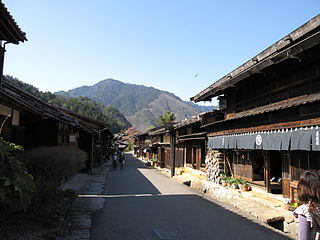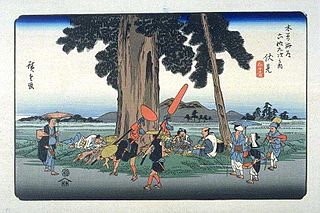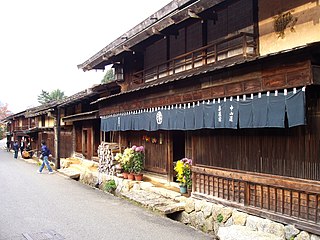
Magome-juku was the forty-third of the sixty-nine stations of the Nakasendō, an ancient road that connected Kyoto and Edo during the Edo period. It was also the last of eleven stations along the Kisoji, which was the precursor to a part of the Nakasendō, running through the Kiso Valley. This well-preserved section of the old route is in the present-day city of Nakatsugawa, Gifu Prefecture, Japan.

Tsumago-juku was the forty-second of the sixty-nine post towns on the Nakasendō. It is located in Nagiso, Kiso District, Nagano Prefecture, Japan. It has been restored to its appearance as an Edo-era post town and is now a popular tourist destination.

Tarui-juku was the fifty-seventh of the sixty-nine stations of the Nakasendō. It is located in the present-day town of Tarui, Fuwa District, Gifu Prefecture, Japan.

Sekigahara-juku was the fifty-eighth of the sixty-nine stations of the Nakasendō. It is located in the present-day town of Sekigahara, Fuwa District, Gifu Prefecture, Japan.

Fushimi-juku was the fiftieth of the sixty-nine stations of the Nakasendō. It is located in the present-day town of Mitake, Kani District, Gifu Prefecture, Japan.

Midono-juku was the forty-first of the sixty-nine stations of the Nakasendō, as well as the ninth of eleven stations on the Kisoji. It is located in the present-day town of Nagiso, in the Kiso District of Nagano Prefecture, Japan. It was originally written as 御殿宿 (Midono-juku).

Banba-juku was the sixty-second of the sixty-nine stations of the Nakasendō. It is located in the present-day city of Maibara, Shiga Prefecture, Japan.

Niekawa-juku was the thirty-third of the sixty-nine stations of the Nakasendō. It is located in the present-day city of Shiojiri, Nagano Prefecture, Japan.

Narai-juku was the thirty-fourth of the sixty-nine stations of the Nakasendō, as well as the second of eleven stations along the Kisoji. It is located in the present-day city of Shiojiri, Nagano Prefecture, Japan.

Nojiri-juku was the fortieth of the sixty-nine stations of the Nakasendō, as well as the eighth of eleven stations on the Kisoji. It is located in the present-day village of Ōkuwa, in the Kiso District of Nagano Prefecture, Japan.

Agematsu-juku was the thirty-eighth of the sixty-nine stations of the Nakasendō, as well as the sixth of eleven stations on the Kisoji. It is located in the present-day town of Agematsu, in the Kiso District of Nagano Prefecture, Japan. From the present-day Jūō Bridge, it runs through the Kan-machi and three other districts, but Edo period row houses from the post town can only be found in Kan-machi. The town originally flourished as a logging town under the protection of the Owari Han.

Fukushima-juku was the thirty-seventh of the sixty-nine stations of the Nakasendō, as well as the fifth of eleven stations on the Kisoji. It is located in the present-day town of Kiso, in the Kiso District of Nagano Prefecture, Japan.

Miyanokoshi-juku was the thirty-sixth of the sixty-nine stations of the Nakasendō, as well as the fourth of eleven stations on the Kisoji. It is located in the present-day town of Kiso, in the Kiso District of Nagano Prefecture, Japan.

Yabuhara-juku was the thirty-fifth of the sixty-nine stations of the Nakasendō, as well as the third of eleven stations on the Kisoji. It is located in the present-day village of Kiso, in the Kiso District of Nagano Prefecture, Japan. Yabuhara-juku is located shortly before the Torii Pass, which was the most difficult part of the Kisoji. Presently, it is known for its omiyage, which are made out of the birch trees that grow nearby.
The Hokkoku Kaidō was a highway in Japan during the Edo period. It was a secondary route, ranked below the Edo Five Routes in importance. Because it was developed for travelers going to Zenkō-ji, it was also called Zenkō-ji Kaidō (善光寺街道). It stretched from the Nakasendō's Oiwake-juku to the Hokurikudō's Takada-shuku. Nowadays, the route is traced by Route 18, stretching between the town of Karuizawa and the city of Jōetsu.

The 53 Stations of the Tōkaidō are the rest areas along the Tōkaidō, which was a coastal route that ran from Nihonbashi in Edo to Sanjō Ōhashi in Kyoto.

Shukuba (宿場) were post stations during the Edo period in Japan, generally located on one of the Edo Five Routes or one of its sub-routes. They were also called shuku-eki (宿駅). These post stations were places where travelers could rest on their journey around the nation. They were created based on policies for the transportation of goods by horseback that were developed during the Nara and Heian periods.


















